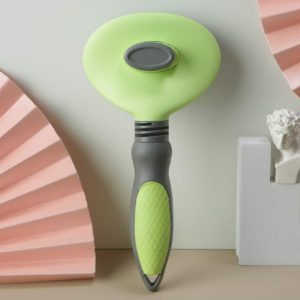
Flawless Pet Supplies

The Ultimate Guide to Potty Training Your Puppy Before It’s Too Late
- By James
Learn the ultimate guide to potty training your two-month-old puppy. Discover effective methods, the importance of early training, and how to use rewards and consequences for success.
Click Bait: The Ultimate Guide to Potty Training Your Puppy Before It's Too Late
Training your two-month-old puppy to potty in a designated spot is a crucial step towards ensuring a clean and harmonious household. While young and seemingly fragile, this is the perfect time to start training because their obedience and memory are at their peak. Establishing good habits early on can prevent future issues and make your life significantly easier.
Why Start Potty Training Early?
Puppies are most receptive to training before they reach six months old. During this period, their ability to learn and adapt is at its highest. Early potty training helps instill good habits that will last a lifetime. If you delay this process, you might find it difficult to correct bad habits later on. According to the American Kennel Club, starting early can lead to better outcomes in terms of behavior and cleanliness (American Kennel Club, 2021).
Effective Potty Training Methods
- Consistency is Key: Consistency in training schedules is vital. After your puppy eats, drinks, or wakes up from a nap, take them to the designated potty area. This helps them associate these activities with the need to go potty.
- Positive Reinforcement: Reward your puppy immediately after they successfully potty in the designated spot. This can be in the form of verbal praise, petting, or a small treat. Positive reinforcement encourages them to repeat the desired behavior.
- Using a Command: Choose a command like “Go potty” or “Do your business” and use it consistently. Over time, your puppy will understand the command and associate it with the action.
- Supervision and Crate Training: When you cannot supervise your puppy, use a crate. Puppies naturally avoid soiling their sleeping area, which helps in teaching them bladder control. Ensure the crate is appropriately sized, allowing them to stand up, turn around, and lie down comfortably.
The Role of Rewards and Consequences
Training is more effective when there is a clear system of rewards and consequences. Here's how to implement them:
- Rewards: After your puppy eliminates in the correct spot, immediately reward them. Use enthusiastic verbal praise like “Good job!” and give them a treat. According to research, immediate rewards are most effective because they directly link the behavior to the positive outcome (Lindsay, 2005).
- Consequences: If your puppy eliminates in an undesired area, a firm “No!” can help. Avoid physical punishment as it can lead to fear and anxiety. Instead, clean the area thoroughly to remove any scent markers. Use enzymatic cleaners designed for pet accidents to eliminate odors completely, which discourages repeat incidents (ASPCA, 2020).
Example: Effective Use of Rewards and Consequences
Consider a puppy named Bella. Bella's owner followed a strict routine of taking her to the potty area 15-20 minutes after eating. Each successful attempt was met with praise and a treat. When Bella had an accident indoors, her owner used a firm voice and cleaned the area with an enzymatic cleaner. Over time, Bella learned to associate the outdoor spot with potty time and significantly reduced indoor accidents.
Setting Up the Potty Area
- Designate a Specific Spot: Choose a specific spot outdoors for your puppy to potty. The consistency of using the same location helps them recognize it as their potty area.
- Indoor Solutions: If you live in an apartment or have limited outdoor access, consider using puppy pads or an indoor dog potty system. Place these in a quiet, low-traffic area of your home.
- Maintain Cleanliness: Keep the potty area clean to encourage your puppy to use it. Remove any waste promptly and sanitize the area regularly.
Statistics on Potty Training Success
A survey by the American Pet Products Association found that 75% of dog owners who started potty training before their puppy was six months old reported faster success rates compared to those who started later (APPA, 2020).
Troubleshooting Common Potty Training Problems
Even with the best methods, you might encounter some challenges. Here's how to address common issues:
- Accidents Indoors: If your puppy has an accident indoors, do not punish them harshly. Instead, interrupt the behavior with a firm “No” and immediately take them to their designated potty spot. Clean the accident area thoroughly with an enzymatic cleaner to remove any scent.
- Inconsistent Results: Consistency is critical. Make sure all family members are following the same potty training routine. If results are inconsistent, reevaluate your schedule and ensure your puppy is being taken to their potty spot regularly.
- Nighttime Training: Young puppies have smaller bladders and may need to potty during the night. Place the crate near your bed so you can hear them if they wake up and need to go out. Gradually, they will be able to hold it longer as they grow older.
Case Study: Overcoming Potty Training Challenges
A puppy named Max struggled with nighttime accidents. His owner decided to take him out once during the night and praised him each time he successfully pottied outside. Within two weeks, Max adjusted and began sleeping through the night without accidents.
Additional Tips for Successful Potty Training
- Feeding Schedule: Maintain a consistent feeding schedule. Puppies usually need to potty soon after eating, so predictability in feeding times helps with potty training.
- Observation: Keep an eye on your puppy for signs they need to go potty, such as sniffing around or circling. Quickly take them to their designated potty area when you notice these signs.
- Patience and Persistence: Training takes time and patience. Stay consistent with your methods and avoid getting frustrated. Positive reinforcement and gentle guidance will yield the best results.
The Importance of Socialization in Potty Training
While potty training, it's also essential to socialize your puppy. Socialization helps your puppy become comfortable with various environments and situations, reducing anxiety and promoting better potty habits. Expose your puppy to different people, places, and experiences. Proper socialization can positively impact their ability to adapt to new potty areas when necessary.
Example: Integrating Socialization with Potty Training
A puppy named Daisy was shy and hesitant to potty outside. Her owner started taking her on short walks to various locations, gradually increasing the distance. By combining socialization with potty training, Daisy became more confident and adapted quickly to different potty areas.
Health Considerations During Potty Training
Ensure your puppy is healthy during the potty training process. Regular veterinary check-ups can help identify any underlying health issues that might affect their potty habits. Conditions like urinary tract infections or gastrointestinal problems can interfere with potty training. Addressing these issues promptly will aid in successful training.
Case Study: Health Impact on Potty Training
A puppy named Rocky had frequent accidents despite consistent training. A veterinary check-up revealed a urinary tract infection. After treatment, Rocky's potty habits improved significantly, highlighting the importance of health in successful potty training.
Conclusion
Potty training your two-month-old puppy might seem daunting, but with consistency, positive reinforcement, and a clear routine, it can be achieved smoothly. Early training sets the foundation for good habits, ensuring your puppy grows into a well-behaved and house-trained adult dog.
By following these guidelines, you can help your puppy learn where to potty and avoid common pitfalls that many new pet owners face. Remember, patience and persistence are key to success.
References
- American Kennel Club. (2021). Potty Training Your Puppy. Retrieved from https://www.akc.org/expert-advice/training/potty-training-your-puppy/
- Lindsay, S. R. (2005). Handbook of Applied Dog Behavior and Training, Procedures and Protocols. Ames, IA: Blackwell Publishing.
- ASPCA. (2020). Preventing Litter Box Problems. Retrieved from https://www.aspca.org/pet-care/dog-care/common-dog-behavior-issues/housetraining-your-dog
- American Pet Products Association. (2020). National Pet Owners Survey. Retrieved from https://www.americanpetproducts.org/pubs_survey.asp
- Chewy. (2022). Earthbath All Natural Pet Shampoo. Retrieved from https://www.chewy.com/earthbath-vanilla-almond-pet-shampoo/dp/144913
- PetMD. (2022). How to Potty Train a Puppy. Retrieved from https://www.petmd.com/dog/training/how-potty-train-puppy
Related Posts


American Bobtail: A Comprehensive GuideAmerican Bobtail
















